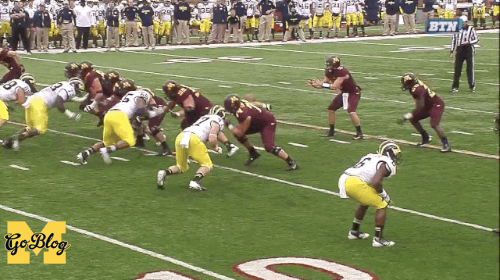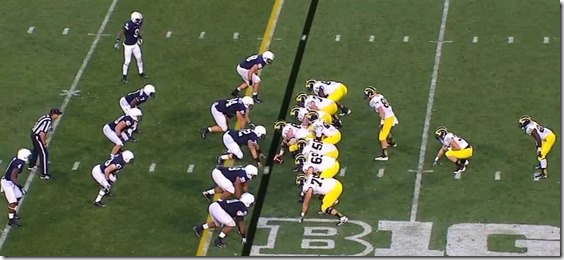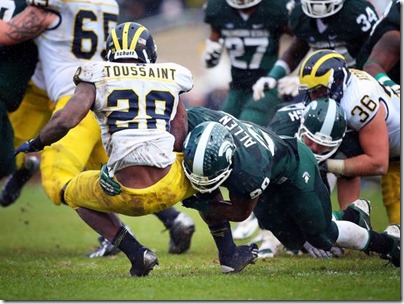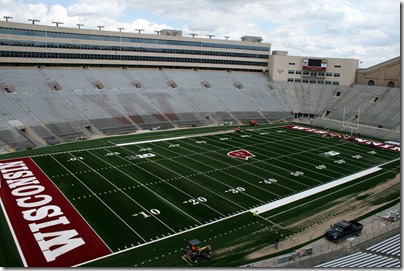lists

Last week we took a look at run defenses, and concluded that Rutgers isn’t the steaming pile of hilarity we’re all expecting. This week, we’re taking the same look at pass defenses. Spoiler alert: Rutgers IS the steaming pile of hilarity we’re all expecting. If not steamier and… uh… more pile-like. The question at hand is as follows: who will have the best pass defense in the Big Ten in 2014?
If you’ve forgotten, we’re just taking a simple two-step process: we look at how good teams were last year at a thing, and we look at attrition among the folks responsible for the thing. Our key assumptions are as follows:
- Experience is good and, all other things being equal, makes things better than they were.
That’s it.
Were they good last year?
Again, this is the easier piece.
Yards per attempt allowed, adjusted for sacks: YPA is generally considered the statistical gold standard for overall goodness of passing games, so it is a pretty useful stat for demonstrating pass defense (It is almost certainly superior to cumulative stats. Yards per game can be misleading based on differing numbers of attempts; Purdue was middle of the pack in terms of YPG allowed, but that’s only because they faced fewer passes because their run defense was so ungodly atrocious, and they were usually behind, so offenses didn’t really feel the need to throw the ball).
We've adjusted for sacks, counting a sack as a pass attempt, which makes sense because if you drop back five times, and complete one pass for 10 yards while getting sacked four times, your yards per attempt should really reflect the fact that attempting to pass went poorly most of the time.
| Team | YPA - sack adj. | |
| 1 | Michigan State | 4.40 |
| 2 | Iowa | 5.11 |
| 3 | Wisconsin | 5.54 |
| 4 | Maryland | 5.57 |
| 5 | Penn State | 5.87 |
| 6 | Nebraska | 5.92 |
| 7 | Ohio State | 6.01 |
| 8 | Northwestern | 6.08 |
| 9 | Michigan | 6.15 |
| 10 | Minnesota | 6.30 |
| 11 | Rutgers | 7.00 |
| 12 | Purdue | 7.10 |
| 13 | Illinois | 7.67 |
| 14 | Indiana | 7.71 |
Passing S&P+ Defense: Click the link for a thorough explanation, but it is an advanced statistical model analyzing what defenses allow on a given play against what you would expect. Advantages are that it takes opponent strength into account, it factors in sacks, and it filters out garbage time. Numbers are national rankings.
| Team | Passing S&P+ | |
| 1 | Michigan State | 1 |
| 2 | Iowa | 13 |
| 3 | Wisconsin | 28 |
| 4 | Nebraska | 41 |
| 5 | Minnesota | 47 |
| 6 | Penn State | 48 |
| 7 | Michigan | 54 |
| 8 | Ohio State | 61 |
| 9 | Maryland | 64 |
| 10 | Northwestern | 73 |
| 11 | Purdue | 76 |
| 12 | Rutgers | 99 |
| 13 | Indiana | 100 |
| 14 | Illinois | 108 |
20+ yard passing plays per game: Completions happen. A team will often gladly offer an opponent a 10 yard completion on 3rd and 17. But 20+ yard completions are a strong indication of a pass defense prone to breakdowns, and one that cannot do the thing it is trying to do.
| Team | 20+ yard passes/game | |
| 1 | Iowa | 1.92 |
| 2 | Michigan State | 2.21 |
| 3 | Wisconsin | 2.77 |
| 4 | Ohio State | 2.93 |
| 5 | Northwestern | 3.00 |
| 6 | Purdue | 3.17 |
| 7 | Michigan | 3.23 |
| 8 | Maryland | 3.31 |
| 9 | Penn State | 3.33 |
| 10 | Minnesota | 3.38 |
| 11 | Nebraska | 3.62 |
| 12 | Illinois | 3.67 |
| 13 | Indiana | 4.00 |
| 14 | Rutgers | 4.46 |
Sacks per game: Sacks can be either a cause of good pass defense or a symptom of good pass defense. A quality pass rush will lead to better defensive results when the opponent tries to pass the ball (see: Nebraska and Ohio State), and solid coverage will lead to more chances for the pass rush to get home with “coverage sacks” (see: Michigan State). It’s hard to separate the two causal possibilities, but for our purposes we don’t need to. They’re both good.
| Team | Sacks/game | |
| 1 | Ohio State | 3.00 |
| 2 | Nebraska | 2.92 |
| 3 | Maryland | 2.69 |
| 4 | Rutgers | 2.46 |
| 5 | Penn State | 2.33 |
| 6 | Michigan State | 2.29 |
| 7 | Northwestern | 2.25 |
| 8 | Wisconsin | 1.92 |
| 9 | Michigan | 1.92 |
| 10 | Iowa | 1.85 |
| 11 | Indiana | 1.67 |
| 12 | Minnesota | 1.39 |
| 13 | Purdue | 1.17 |
| 14 | Illinois | 1.17 |
Putting it together
Here is how the teams shake out in rough order of how they fared in the above categories, with emphasis on the first two categories.
| YPA | S&P+ | 20+ plays/game | Sacks/game | |
| Michigan State | 1 | 1 | 2 | 6 |
| Iowa | 2 | 2 | 1 | 10 |
| Wisconsin | 3 | 3 | 3 | 9 |
| Nebraska | 6 | 4 | 11 | 2 |
| Penn State | 5 | 6 | 9 | 5 |
| Maryland | 4 | 9 | 8 | 3 |
| Ohio State | 7 | 8 | 4 | |
| Michigan | 9 | 7 | 7 | 8 |
| Minnesota | 10 | 5 | 10 | 12 |
| Northwestern | 8 | 10 | 5 | 7 |
| Purdue | 12 | 11 | 6 | 14 |
| Rutgers | 11 | 12 | 14 | 4 |
| Indiana | 14 | 13 | 13 | 11 |
| Illinois | 13 | 14 | 12 | 13 |
Like last week the teams generally break out into four tiers:
-
MSU – MSU.
- Again, they get their own tier because obviously.
-
Pretty Good – Iowa, Wisconsin.
- Great YPA numbers, minimized big plays, didn’t get home much on pass rush.
-
Meh - Penn State, Maryland, Ohio State, Michigan, Nebraska, Northwestern, Minnesota.
- The great undifferentiated mass of mediocre pass defenses. All allowed between 5.87 and 6.30 YPA (other than Maryland, who played a weaker schedule last year). All but Northwestern had S&P+ pass rankings between 41st and 64th.
-
Butt (NJB) – Purdue, Rutgers, Indiana, Illinois.
- If you’re curious, all four of these teams performed comparably with, and perhaps even worse than, Michigan’s 2010 pass defense.
[AFTER THE JUMP: Attrition tolls for thee. If thee be Ohio State or Nebraska]

Unrelated but never unrelated (h/t @smartfootball)
Ranking things is fun, or at least so BuzzFeed tries to tell me every freaking day of my life. And just like any prediction, rankings that attempt to predict the future are typically a fool’s errand. But we are fools, so ON WITH THE PREDICTING.
Trying to project year-to-year development in college football is tricky at best. But we can also try extrapolate by asking two relatively simple questions: (1) were they good at the thing last year, and (2) how many of the people who did the thing last year will be back this year?
The question of the day is this: which Big Ten team will have the best run defense in 2014?
Were they good last year?
This part is easy. There are many ways to break down how effective various run defenses were last year, and while none is perfect, together they give a pretty comprehensive picture. A few of the key measurements:
Yards per carry (sacks removed) - Pretty basic. When the opposing offense tried a run the ball, how far did they go?
|
B1G rank |
Team |
YPC (w/o sacks) |
| 1 | Michigan State | 3.61 |
| 2 | Wisconsin | 3.80 |
| 3 | Rutgers | 3.82 |
| 4 | Iowa | 4.07 |
| 5 | Ohio State | 4.29 |
| 6 | Michigan | 4.42 |
| 7 | Maryland | 4.54 |
| 8 | Nebraska | 4.60 |
| 9 | Penn State | 4.67 |
| 10 | Northwestern | 4.83 |
| 11 | Minnesota | 5.03 |
| 12 | Purdue | 5.60 |
| 13 | Indiana | 5.90 |
| 14 | Illinois | 5.93 |
Rushing Defensive S&P+ ranking – A fancy rejiggering of statistics based on outcomes for every running play a defense faces.
|
B1G Rank |
Team |
Rushing S&P+ (nat’l rank) |
| 1 | Michigan State | 2 |
| 2 | Iowa | 7 |
| 3 | Penn State | 8 |
| 4 | Wisconsin | 9 |
| 5 | Rutgers | 22 |
| 6 | Michigan | 33 |
| 7 | Maryland | 42 |
| 8 | Northwestern | 57 |
| 9 | Ohio State | 58 |
| 10 | Indiana | 75 |
| 11 | Purdue | 76 |
| 12 | Minnesota | 79 |
| 13 | Illinois | 83 |
| 14 | Nebraska | 84 |
Adjusted Line Yards – A breakdown of yards per rush compared to what would be statistically expected, and then adjusted for level of competition.
|
B1G Rank |
Team |
Adj. Line Yards (nat’l rank) |
| 1 | Michigan State | 2 |
| 2 | Penn State | 13 |
| 3 | Iowa | 14 |
| 4 | Wisconsin | 17 |
| 5 | Rutgers | 31 |
| 6 | Maryland | 35 |
| 7 | Michigan | 45 |
| 8 | Indiana | 49 |
| 9 | Minnesota | 58 |
| 10 | Illinois | 62 |
| 11 | Northwestern | 77 |
| 12 | Purdue | 79 |
| 13 | Nebraska | 88 |
| 14 | Ohio State | 96 |
And taking the Big Ten rankings for the various stats together, you get the following rough composite order. Being higher is better and being lower is worse (which you would have known anyway based on the teams at the top and bottom):
|
Team |
YPC |
S&P+ |
Adj. LY |
| Michigan State | 1 | 1 | 1 |
| Iowa | 4 | 2 | 3 |
| Wisconsin | 2 | 4 | 4 |
| Rutgers | 3 | 5 | 5 |
| Penn State | 9 | 3 | 2 |
| Michigan | 6 | 6 | 7 |
| Maryland | 7 | 7 | 6 |
| Ohio State | 5 | 9 | 14 |
| Northwestern | 10 | 8 | 11 |
| Indiana | 13 | 10 | 8 |
| Minnesota | 11 | 12 | 9 |
| Nebraska | 8 | 14 | 13 |
| Purdue | 12 | 11 | 12 |
| Illinois | 14 | 13 | 10 |
So 2013 defensive front performances look to shake out into a few tiers:
- Michigan State: They get a tier all their own. I probably don’t have to explain this.
- Pretty good: Rutgers, Iowa, Wisconsin, Penn State
- Meh: Maryland, Michigan, Ohio State
- Butt (Not Jake Butt): Northwestern, Nebraska, Indiana, Minnesota, Purdue, Illinois
How much do they return?
Answering the question "how many starters from the front seven return?" is a little trickier. Take Michigan for example: how many defensive starters did they lose? They lost Jibreel Black and Quinton Washington, but weren’t they kind of the same guy? Do you count that as two starters lost, or one? In a way, it doesn’t matter, as we’re just trying to get a sense for what various teams lost, not necessarily to quantify it. However, to give a very rough estimate of the kind of production everyone is losing, I included the percentage of the team’s total tackles accounted for by guys I deemed to be departing starters from the front seven.
Denicos Allen is gone. Clearly MSU will now be terrible.
The obvious caveats. The first is that tackles are an inexact proxy for quality. A mediocre inside linebacker will usually make more tackles than a top-flight defensive tackle (Nebraska LB David Santos made 87 tackles. Penn State DT DaQuan Jones made 56. Jones was first team All-B1G and a 4th round draft pick. Santos was terrible and was replaced by a freshman mid-season). However, we’re doing qualitative analysis with a quantitative kicker, not the reverse, so it’s helpful information that isn’t vital to our thesis. The second caveat is that the front seven aren’t the only people involved in run defense. Solid safety play is a big deal.
So, here’s where we are:
|
Team |
How good in 2013? |
Returning starters (Front 7) |
% of tackles by lost starters |
| Indiana | Butt | 7 | 0 |
| Maryland | Meh | 7 | 0 |
| Michigan | Meh | 6 | 2.9 |
| Nebraska | Butt | 5 | 7.3 |
| Rutgers | Pretty good | 5 | 9.5 |
| Ohio State | Meh | 6 | 15.7 |
| Penn State | Pretty good | 5 | 16.8 |
| Minnesota | Butt | 4 | 19.4 |
| Northwestern | Butt | 4 | 20.3 |
| Purdue | Butt | 3 | 20.3 |
| Illinois | Butt | 4 | 20.6 |
| Michigan State | MSU | 3 | 27.7 |
| Iowa | Pretty good | 3 | 34.6 |
| Wisconsin | Pretty good | 0 | 38.2 |
They run the gamut from returning everyone (Indiana) to returning no one (Wisconsin).
A pattern emerges
You may notice that the better defenses are the ones that lose more people. This makes intuitive sense; defenses with more seniors are, all things being equal, better. Of the four defenses we labeled as “MSU” or “Pretty Good,” three (MSU, Iowa, and Wisconsin) suffer serious losses, and I’d argue those were the three best run defenses last year.
So, who are the contenders for Best Run Defense for 2014?
Contenders based on returning talent
Michigan
- 4.22 YPC
- #33 S&P+
- #45 Adj. LY
- 6 returning starters
Michigan returns all of the major pieces of a run defense that was fair-to-good. Other than getting shredded by OSU for 393 yards at 8.5 YPC, they didn’t surrender more than 170 yards or 5 YPC in any of their other games. Add a healthy Jake Ryan, and if the defensive tackle play is good Michigan looks primed for a big year.

There is no advanced stat that appropriately values “beat running back to death with quarterback”.
Rutgers
- 3.82 YPC
- #22 S&P+
- #31 Adj. LY
- 6 returning starters
I love a good Rutgers joke as much as anyone (you know what’s a good Rutgers joke? Rutgers), but they actually had a solid run defense last year. They had the third-best YPC average (albeit against weaker competition), and they have some solid talent in the front seven with Darius Hamilton, WLB Steve Longa, and MLB Kevin Snyder. Granted, the run defense might just look good because Rutgers’ pass defense is so unbelievably bad, but such is life in Piscataway.
Maryland
- 4.54 YPC
- #42 S&P+
- #35 Adj. LY
- 7 returning starters
Like Rutgers, we like to make Maryland jokes, but the run defense was pretty solid, and they return their entire front seven. Darius Kilgo and Andre Monroe anchor their 3-4 defense and do an excellent job of keeping linebackers clean. If they can stay healthy (never a guarantee at Maryland these days), they will be very good again.
Penn State
- 4.67 YPC
- #8 S&P+, #13 Adj. LY
- 5 returning starters
Much like Michigan, Penn State had one implosion of a defensive game (also against Ohio State) and generally held up very well otherwise. You may recall 27-for-27 as a thing that happened. They lose DaQuan Jones, but they return C.J. Olaniyan and Deion Barnes. If MLB Mike Hull can avoid that always-troubling 37th major injury, Penn State could contend for top honors, though depth remains a concern.

Penn State reacted well to subtlety
Contenders based on history
Michigan State
- 3.61 YPC
- #2 S&P+
- #2 Adj. LY.
- 3 returning starters
State lost both starting defensive tackles, uber-productive (and TOTALLY NOT SUSPICIOUS IN ANY WAY) MIKE Max Bullough, and Denicos Allen. But I’m not an idiot, and the last thing I’m going to declare is that Michigan State will be taking some giant step back. The internet remembers such stupid declarations and revisits them. In the last 6 years, MSU’s rushing defense S&P+ rating (in chronological order) was #28, #23, #31, #5, #2, and #2. They have finished as the best rushing defense (in terms of YPC) in the Big Ten the last three years. Shilique Calhoun isn’t a great run-defender, but Marcus Rush and Taiwan Jones are pretty good, and… yeah. Again. Not an idiot.
Iowa
- 4.07 YPC
- #7 S&P+
- #14 Adj. LY
- 3 returning starters
Iowa loses their entire linebacking corp, along with their 322 combined tackles. The remaining linebackers on the roster had 29 tackles last year. Combined. Howeverm Iowa returns almost all of the best defensive lines in the conference, including two of the best defensive tackles in Carl Davis and Louis Trinca-Pasat. Iowa’s worst defensive rushing performance in the last six years was roughly on par with Michigan’s performance last year, and they have been a top-30 rushing defense almost every year. Ferentz has zombie powers, so it could happen.
Pretenders
Wisconsin
- 3.80 YPC
- #9 S&P+
- #17 Adj. LY
- 0 returning starters
The 2013 Wisconsin Badgers had a very good starting front seven. But so did the ’85 Bears. And those two groups have something in common: none of them will be lining up for Wisconsin in 2014. The Badgers didn’t just lose nominal starters, either: Chris Borland alone accounted for an estimated 793 tackles per game. They return SOME production along the DL in Konrad Zagzebski and Warren Herring, but this is almost entirely a reclamation job. Wisconsin doesn’t have a history of dominant rush defenses either; their average S&P+ rush defense form 2008-2012 was #33 in the country, and their average Big Ten rank in YPC over that time was a shade better than 6th in the conference. Unless Gary Andersen is a wizard of some kind, regression beckons.
Hey, look, it’s Wisconsin’s front seven.
Nebraska
- 4.60 YPC
- #84 S&P+
- #88 Adj. LY
- 5 returning starters
Nebraska has the opposite problem Wisconsin had. The Huskers bring almost everyone back, but the guys they bring back weren’t very good last year. Nebraska was really good at getting to the QB last year (2nd only to OSU), which combined with a soft schedule to make their raw yards-per-carry numbers look somewhat decent. But remove those sacks or take anything other than a surface glance, and Nebraska wasn’t good on the ground. Randy Gregory is a hell of a pass rusher, but he’s not great against the run. It’s unlikely Nebraska will be in the conversation at the end of the year.
Indiana
- 5.90 YPC
- #75 S&P+
- #49 Adj. LY
- 6 returning starters
Hey, they return a lot of guys. Lloyd Christmas dot jpg.
Not even pretending
Teams that weren’t good last year and have to replace significant portions of those not-good defenses
Northwestern
- 4.83 YPC
- #57 S&P+
- #77 Adj. LY
- 4 returning starters
Remember when they were ranked last year?
Minnesota
- 5.03 YPC
- #79 S&P+
- #58 Adj. LY
- 4 returning starters
Thieran Cochran is good. The rest of Minnesota is not good.
Purdue
- 5.60 YPC
- 76 S&P+
- #79 Adj. LY
- 3 returning starters
/Buuuuuuuuuuuurp.
Illinois
- 5.93 YPC
- #83 S&P+
- #62 Adj. LY
- 4 returning starters
Gave up over 250 yards in 7 different games. Only held one power conference team under 4 YPC. Gave up 29 rushing TDs. Was bad.
My answer is ‘I don’t have the first damn clue’
Ohio State
- 4.29 YPC
- #58 S&P+
- #96 (!!!) Adj. LY
- 6 returning starters
They had a good YPC average, but the advanced statistics say they were somewhere between bad and abysmal. They only lose one starter, but that starter (Ryan Shazier) made 144 tackles and 23.5 tackles for loss. They return theoretically one of the best lines on the country, but how good can it be if it was so bad against the run last year? I am perplexed.
Strictures require that I take a guess
My monkey-choosing-mutual-funds stab at the 2014 sack-free YPC rankings:
- Michigan State
- Michigan
- Rutgers
- Maryland
- Penn State
- Ohio State
- Iowa
- Wisconsin
- Nebraska
- Indiana
- Northwestern
- Minnesota
- Purdue
- Illinois


18